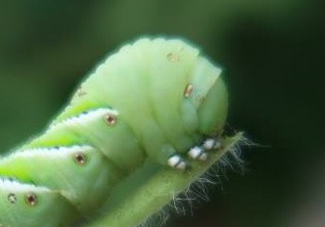The tomato hornworm is known by the scientific name Manduca quinquemaculata and belongs to the family of Sphingidae. It is considered a garden pest. It mostly feeds on plants that belong to the Solanaceae family such as potatoes, tomatoes, peppers, and eggplant. The adult tomato hornworm is a reasonably large and muscular moth, also known as a sphinx moth or a hawk moth. This adult feeds on the nectar of many flowers and is most active from twilight to morning, just like the larval form.
Hornworms are the longest caterpillars that are mostly seen in Minnesota; their length reaches up to four inches. These caterpillars are the larvae of the hawk moth. Tomato hornworms possess a black horn on their back and white V-shaped markings on their sides. The sides are bright green colored.
These caterpillars reside in the North. The large-sized tomato hornworms appear in the late spring and release their eggs on plant leaves at night. The adult female moth can release up to 2000 eggs in ideal conditions.
Tomato Hornworm Life Cycle
Tomato hornworms are pupae that survive the winter and emerge as mature moths in the spring. Females lay light green, round, and smooth eggs on the lower and top leaf surfaces after mating. In three to four weeks, caterpillars hatch, begin feeding and reach full length. The grown caterpillars detach from the leaves then they burrow themselves into the earth to pupate.
After pupating, in two weeks, moths start a second generation. Midsummer is the time of year when moths emerge to start a second generation. The moths of the second generation lay eggs on tomato plants. After feeding until the early fall, caterpillars go through the metamorphosis process. The pupae spend the winter in the soil. This is how the life cycle continues.
Tomato Hornworm Eggs
The adult moths mate and the females lay eggs on the hostplant. The eggs are quite small in size that is approximately 1mm in diameter. The shape of the eggs is round and they appear tiny, smooth, and yellow-green. The adult females lay 2000 eggs under normal and suitable conditions.
Depending on the temperature, it takes about four days for the hornworms to hatch from their eggs. They turn white before they emerge from the womb. Hornworms start to come out at the beginning of June, and they keep coming out for the rest of the planting period.
Tomato Hornworm Damage
Potato, eggplant, and pepper are identified as hosts of these hornworms but tomato is the preferred host. Many weeds, including horsenettle, jimsonweed, and nightshade, act as substitute hosts for the caterpillars. In the gardens, the vast proportion of the caterpillars quickly damages the hostplants.
The tomato hornworms damage the hostplants by eating the leaves that are on the top. they eat entire leaves, as well as flowers and fruit. The plant’s uppermost sections are frequently the first to succumb to pests. It becomes difficult to notice the damage because the caterpillars mix in with the foliage. As they consume food, they produce black or dark green that is easily visible. The degree of defoliation increases as they grow larger.
Tomato hornworm Control
Tomato hornworms are often easy to prevent in a home garden by regularly inspecting plants for the appearance of caterpillars. Hand-picking caterpillars off of plants is an efficient method of pest control; however, there are other pesticides available for use in situations when handpicking is impractical. A biological insecticide called Bacillus thuringiensis is a commonly accessible organic solution for controlling caterpillars. For the Bt to work, caterpillars must consume it.
Some other management techniques are as follows:
- Natural enemies such as green lacewings and lady beetles help in controlling the tomato hornworms.
- The paper wasp is another major predator. This common insect feeds on a variety of tomato hornworms.
- In most cases, pesticides are not required. However, if alternative solutions are not working or are not practicable, then pesticides are preferred.
- Smaller caterpillars are managed more easily than larger ones. A pesticide such as Spinosad is used to manage this caterpillar.
- Soaps formulated to kill insects are more successful when applied to caterpillars of a smaller size.
- Permethrin, pyrethroids, lambda-cyhalothrin, cyfluthrin, and Bifenthrin are some of the broad-spectrum insecticides that are effective for the management of tomato hornworm.
- The modification of the surrounding area is also preferred to discourage the spread of these caterpillars.
- Reduce the amount of worm egg-laying locations by eliminating weeds.



